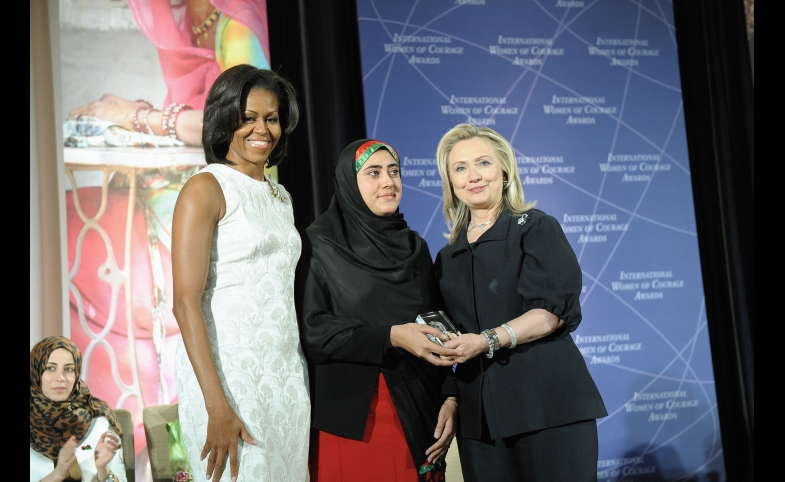Over 200 years ago, President George Washington warned Americans about foreign powers undermining American democracy by tampering “with domestic factions, to practice the arts of seduction, to mislead public opinion, to...
KEEP READINGThe CPD Blog is intended to stimulate dialog among scholars and practitioners from around the world in the public diplomacy sphere. The opinions represented here are the authors' own and do not necessarily reflect CPD's views. For blogger guidelines, click here.

In Choosing Female Leaders, U.S. Trails Behind Many Nations
CPD Editor’s Note: This post originally appeared in the Sacramento Bee.
Every election brings new questions about the qualities and character of national leadership, in the United States and abroad.
In the 2008 presidential election, the big question was whether America could elect a nonwhite man—in this case, an African American—as president. Up until then, all U.S. presidents had been white Christian males of European descent.
But disruption was in the air. France, for example, had selected a Greco-Hungarian of Jewish ancestry as president the year before Barack Hussein Obama’s victory.
In 2016, as the country moves through its primary season, U.S. voters are considering making history in other ways. Will they elect a septuagenarian Jewish socialist, a boisterous billionaire political neophyte, a Cuban-American born outside the United States? Or, after a few years of primary female also-rans, finally elect a woman to the highest office in the land?
Developed and developing states choose women. So do transitioning democratic states.
If the United States does elect a woman, whether Hillary Clinton, a Republican-convention-brokered female candidate (Carly Fiorina? Condoleezza Rice?) or perhaps a write-in third-party contender as president, it would be following the lead not only of the world’s most developed nations, but of many countries spanning a broad economic and political spectrum.
Impoverished India, the world’s largest democracy, chose Indira Gandhi as prime minister from 1966 to 1977. Next door, India’s greatest adversary, Pakistan, also chose a woman, two-term Prime Minister Benazir Bhutto. Both women served, neither was a pushover, and both paid the ultimate price for their service: They were assassinated.
Less violently, America’s closest allies, Britain and Israel, have had strong female leaders in Margaret Thatcher and Golda Meir (the latter an American by birth). America’s NATO allies in Europe did not think twice when they chose Norwegian Prime Minister Gro Harlem Brundtland to serve three terms, while Germany’s Chancellor Angela Merkel initially was appointed in 2005. Merkel also became the European Council’s president in 2007, a role once held by Britain’s “Iron Lady,” Margaret Thatcher.
Prime ministers and chancellors are chosen by their parties, but female leaders have won direct popular elections, too. Iceland’s President Vigdís Finnbogadóttir served from 1980 to 1996 and was that country’s—and Europe’s—first female president and feminist-in-chief.
In Asia, Corazon Aquino eschewed the opulence of the toppled Ferdinand Marcos’ regime and the traditional Malacañang Palace during her six-year Philippine presidency. In South America, Michelle Bachelet is serving her second non-consecutive term as president of Chile. Ireland’s former president Mary Robinson is now the U.N. High Commissioner for Human Rights—a task of increasing importance and attention.
Developed and developing states choose women. So do transitioning democratic states, such as Myanmar’s Aung San Suu Kyi. When Taiwan decided to play tough with the world’s most populous nation, China, it chose Tsai Ing-wen to take office next month.
In Africa, the estimable Ellen Johnson Sirleaf, the Liberian leader and Nobel Prize winner, is a paragon of ethics and leadership, and brings dignity and a reform agenda to a troubled country and continent.
When it comes to leading a country, size does not matter. In teeny-tiny San Marino, 17 women have been heads of state since 1981.
Big or small, there is not a continent on Earth that has failed to elect a woman to lead a nation...well, two: North America and Antarctica.
That’s not to say that elected, appointed or anointed female heads of state are a panacea for global, or even local, problems. Corruption and failure are gender neutral and an equal-opportunity temptation for all races, religions, creeds and sexes. A look south reveals two embattled Latin American leaders on the brink of trial or impeachment: Argentina’s recent former President Cristina Fernández de Kirchner and Brazil’s current highest officeholder, Dilma Rousseff.
It took the elevation of Nancy Pelosi to the role of speaker of the U.S. House of Representatives in 2007 to change the North American meaning of “a woman’s place is in the house.” Around the world, a woman’s place is not only in the House leadership, but also as leaders of senates and other representative, administrative and judicial bodies. And here in the United States, it may soon be that a woman’s place is in the most important house of all—the White House.
(Disclosure: My wife served as a U.S. ambassador under Secretary of State Hillary Clinton and actively supports her.)
Photo by U.S. Department of State I CC 2.0
Visit CPD's Online Library
Explore CPD's vast online database featuring the latest books, articles, speeches and information on international organizations dedicated to public diplomacy.
POPULAR ARTICLES
-
March 22
-
February 23
-
February 22
-
April 1
-
April 11
Join the Conversation
Interested in contributing to the CPD Blog? We welcome your posts. Read our guidelines and find out how you can submit blogs and photo essays >.













